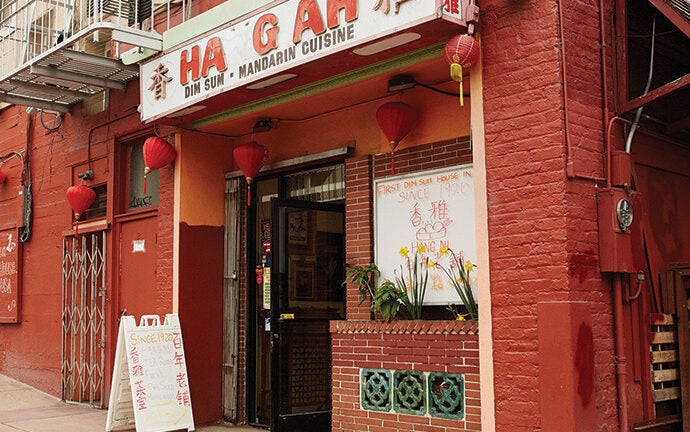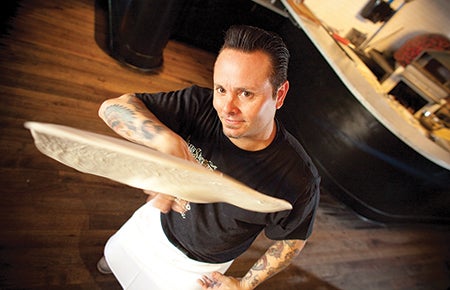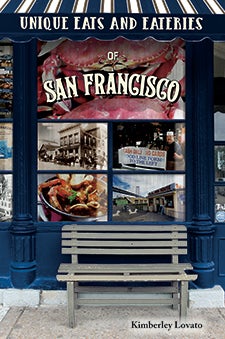
Food-loving alumna chronicles fascinating tales behind San Francisco’s iconic eateries
“Want to taste the prize-winning pie of a 12-time World Pizza Champion? Eat your homework at America’s only independent cheese school? Track down the home of the Mission-style burrito?”
This is the intriguing exhortation — appetite- and curiosity-whetting in equal measure — that appears on the back cover of alumna Kimberley Lovato’s new book, Unique Eats and Eateries of San Francisco (Reedy Press, 2017). Lovato, a food-lover by nature and a San Franciscan by choice, says that when the opportunity came along to write a food guide to her beloved adoptive city, she didn’t hesitate.
“What intrigued me about this project was that it was not a review of restaurants,” she said. “It’s really about the stories behind the restaurants, the anecdotes or memories of the chefs and owners who created them.”

Kimberley Lovato’s new book features behind-the-scenes tales of San Francisco chefs like Tony Gemignani, a 12-time world pizza champion who limits creation of his award-winning pies to just 73 a day. Photo by Sara Remington.
The result is a nontraditional restaurant and travel guide that features a feast of delectable tidbits about the city’s most celebrated eateries, as well as many of its more secret culinary destinations. Lovato has succeeded in marinating these diverse ingredients to create a delicious smorgasbord of “90 palate-pleasing bites” of San Francisco food lore. The book is a moveable feast, a portable collection of mouthwatering tales that can be savored equally by visitors or long-time residents.
For Lovato, San Francisco is a place where food and memory are inextricably linked. “It’s hard not to be hypnotized by a city that buzzes at this level of culinary velocity,” she wrote.
As one key to understanding the city, she cites cioppino, a fisherman’s stew loaded with crab, clams, fish and sometimes shrimp, that is the city’s signature dish. “It actually goes back to a time when Italian immigrants working on the water front would throw leftover scraps into a pot with tomatoes and boil it up.”

Kimberley Lovato honed a love of writing while at USC Dornsife. Photo courtesy of Reedy Press.
Traveling with a knife and fork
Food, she believes, is an important stepping stone to gaining a deeper understanding of the history and culture of a place.
She describes her first book, Walnut Wine and Truffle Groves: Culinary Adventures in the Dordogne (Running Press, 2010), as a way to introduce readers to the people behind the kitchen door by sharing a meal with them. “I love to travel with a knife and fork at the ready,” she says.
Lovato, who earned a bachelor’s in international relations with a French minor, said her USC Dornsife education has helped her career as a writer.
“I had a fairly sheltered upbringing, and going to USC opened my eyes to people from all over the world — different cultures, food, music.”
After graduating, Lovato took a job with a small electronics manufacturer, but she realized five years later that corporate America wasn’t for her.
“Instead I focused on doing what I love — writing — and took a job with a local newspaper,” she said.
Coincidentally, one of her first assignments involved interviewing a Greek chef, thereby setting the groundwork for her future career.

Kimberley Lovato believes that food is an important key to understanding the history and culture of a place.
Authentic dining
For her latest book, she said she wanted to include classics, as well as places that were a surprise to her, too.
While researching the book, she stumbled upon the Hang Ah Tea Room, the country’s oldest dim sum restaurant, in a Chinatown alleyway, far from the beaten tourist track. “The sign is missing a letter and it’s kind of dark and you think, ‘Hmm, I’m not sure I want to go in there,’ but it’s delicious.”
Lovato’s book traces how fortune cookies — originally a Japanese creation — came to America via San Francisco. She writes about the curiously named San Francisco delicacy hangtown fry — an oyster and bacon omelet that first became popular during the Gold Rush — so called because of the hangings that took place in Placerville, its town of origin.
“Hangtown fry is a rare treat in San Francisco today, but can still be found on a few menus, like that of Tadich Grill,” Lovato said. “If you visit San Francisco and order cioppino or hangtown fry, you’re really trying an authentic and historic San Francisco dish.”